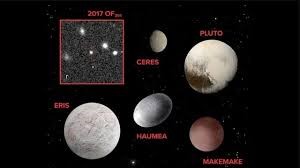New Dwarf Planet Discovery Challenges Planet Nine Theory in Our Solar System
New Dwarf Planet Discovery Challenges Planet Nine Theory in Our Solar System
Why in the News?
A team of US-based astronomers has made a new planet discovery, identifying a new dwarf planet named 2017 OF201 in the outer solar system, potentially challenging the Planet Nine hypothesis. This finding, part of ongoing efforts to map our solar system, understand all planets’ names and their distances from the sun, and even update solar system class 8 curriculum, came after a year-long analysis of archival data.
Discovery of 2017 OF201:
- A US-based team, including an amateur astronomer and a citizen scientist, stumbled upon a potential dwarf planet, 2017 OF201, while searching for the elusive Planet Nine, also known as Planet X. This discovery involved collaboration between professional astronomers and previously unknown scientists in the field.
- It is located three times farther than Neptune from Earth and has a highly elongated orbit, swinging out over 1,600 AU (Astronomical Units) — well into the Oort Cloud, far beyond the region where most known solar system planets reside.
- The object is around 700 km in diameter, making it one-third the size of Pluto. This comparison naturally raises the question: is Pluto a planet? The answer to why Pluto is not a planet lies in the International Astronomical Union’s definition, which 2017 OF201 also meets, qualifying it as a dwarf planet.
- Its orbit takes 25,000 years to complete, and it is only observable for about 1% of its orbit, or a century, making it a challenging target for telescopes like the Hubble telescope and the James Webb telescope.
Implications for Planet Nine Hypothesis
- The discovery may challenge the Planet Nine theory, which postulates a massive planet influencing the orbits of icy rocks and other Kuiper Belt objects beyond Neptune through its gravitational pull.
- Lead author Sihao Cheng from the Institute for Advanced Study said their finding suggests there could be hundreds of similar objects in the Kuiper Belt, not just one large body causing clustered orbits.
- This supports the idea of many smaller dwarf planets instead of a singular large one affecting orbital patterns in the outer solar system. Dr. Samantha Lawler from the University of Regina, who was not involved in the study, commented on the significance of this discovery for our understanding of the solar system’s architecture.
Future Observations and Scientific Value
- Astronomers, including Sam Deen, another researcher involved in the study, have requested observation time on the James Webb Space Telescope (JWST), Hubble, and ALMA telescope to further study this strange planet and other potential planets in the solar system.
- 2017 OF201 may have even interacted with other stars in the past, due to the extremity of its orbit, providing valuable insights into the dynamics of our solar system.
- The finding adds to the growing list of known dwarf planets, including Pluto, and reflects the ongoing evolution of our solar system’s map. It highlights the importance of open science and collaborative efforts between professional astronomers and amateur stargazers in expanding our understanding of the planets in the solar system.
- This discovery, registered with the International Astronomical Union’s Minor Planet Center, opens up new possibilities for studying the outer reaches of our cosmic neighborhood and may lead to the identification of other hypothetical worlds or even a planet similar to Earth in the vast expanse of space.
As we continue to explore and map our solar system, discoveries like 2017 OF201 remind us that there is still much to learn about the celestial bodies that share our cosmic neighborhood. From the inner rocky planets to the mysterious objects in the Kuiper Belt and beyond, each new finding helps us piece together the complex puzzle of our solar system’s formation and evolution. The upcoming Vera Rubin Observatory is expected to significantly contribute to our understanding of these distant objects and potentially reshape our knowledge of the solar system’s outer regions.




